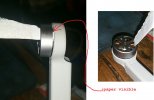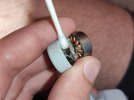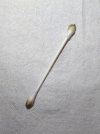Recently I had a strange issue with my Mini 2, I hope that there is someone here that understands brushless motors and could explain what went wrong. So, this is what happened:
In a beautiful morning, some days ago, I took my Mini 2 out to record some nice holiday footage. I landed the drone in my hand in order to avoid stuff getting into the motors when landing on the ground. All good and no issues. I folded the drone and carefully put it back in the case. Then, in the evening, I wanted to take some more shots, so I took the drone out again and put in on a clean picnic table in order to take off. When starting the motors with the CSC, the left rear motor wouldn't rotate, and the other three would stop after rotating for two seconds. In the DJI Fly app I got an error saying "Motor unable to rotate. Check motor". I tried for a few times, powered the drone off and on again, made sure the props don't touch anything, but with the same result. Then, with the drone powered off, I manually rotated the motor, and noticed it had a different feeling than the other three. The three motors that worked fine all had a similar feeling: they would spin very easily and had a regular magnetic clicking/snapping feel. The bad motor however didn't have this snapping feel, and was more difficult to rotate. It still was rotating very smoothly, but it just required more force to spin it. There was absolutely no grinding feel/sound, confirming the issues was not something getting into the motor.
I was 100% sure nothing got into it, also because of how careful I handle the drone. Regardless, I still removed the props, carefully inspected it using a magnifier, lightly tapped it with some plastic thing, and tried to vacuum out any potential stuff that got into it. All without results, because this was not the issue. The error was still there, and the motor wouldn't start. Disappointed, I folded the drone and put it back in the case.
The next day, I wanted to show the issue to my brother. So I took out and unfolded the drone, and I asked him to manfully rotate the motors to see what I was talking about. He couldn't feel any difference between the four motors, and neither did I. The issues was magically gone, the troubled motor would easily spin and have the snappy feel like the other three. I powered the drone and all motor worked fine, and the drone flew flawlessly.
So, what went wrong here? Is it possible for a bug in the software to cause this issue, and the different "feel" of the motor, when manually rotating it ?
In a beautiful morning, some days ago, I took my Mini 2 out to record some nice holiday footage. I landed the drone in my hand in order to avoid stuff getting into the motors when landing on the ground. All good and no issues. I folded the drone and carefully put it back in the case. Then, in the evening, I wanted to take some more shots, so I took the drone out again and put in on a clean picnic table in order to take off. When starting the motors with the CSC, the left rear motor wouldn't rotate, and the other three would stop after rotating for two seconds. In the DJI Fly app I got an error saying "Motor unable to rotate. Check motor". I tried for a few times, powered the drone off and on again, made sure the props don't touch anything, but with the same result. Then, with the drone powered off, I manually rotated the motor, and noticed it had a different feeling than the other three. The three motors that worked fine all had a similar feeling: they would spin very easily and had a regular magnetic clicking/snapping feel. The bad motor however didn't have this snapping feel, and was more difficult to rotate. It still was rotating very smoothly, but it just required more force to spin it. There was absolutely no grinding feel/sound, confirming the issues was not something getting into the motor.
I was 100% sure nothing got into it, also because of how careful I handle the drone. Regardless, I still removed the props, carefully inspected it using a magnifier, lightly tapped it with some plastic thing, and tried to vacuum out any potential stuff that got into it. All without results, because this was not the issue. The error was still there, and the motor wouldn't start. Disappointed, I folded the drone and put it back in the case.
The next day, I wanted to show the issue to my brother. So I took out and unfolded the drone, and I asked him to manfully rotate the motors to see what I was talking about. He couldn't feel any difference between the four motors, and neither did I. The issues was magically gone, the troubled motor would easily spin and have the snappy feel like the other three. I powered the drone and all motor worked fine, and the drone flew flawlessly.
So, what went wrong here? Is it possible for a bug in the software to cause this issue, and the different "feel" of the motor, when manually rotating it ?














